
Click here to download the PDF.
Section I
The Exam
AP ® English Literature and Composition Exam
SECTION I: Multiple-Choice Questions
DO NOT OPEN THIS BOOKLET UNTIL YOU ARE TOLD TO DO SO.
At a Glance
Total Time
1 hour
Number of Questions
55
Percent of Total Grade
45%
Writing Instrument
Pencil required
Instructions
Section I of this examination contains 55 multiple-choice questions. Fill in only the ovals for numbers 1 through 55 on your answer sheet.
Indicate all of your answers to the multiple-choice questions on the answer sheet. No credit will be given for anything written in this exam booklet, but you may use the booklet for notes or scratch work. After you have decided which of the suggested answers is best, completely fill in the corresponding oval on the answer sheet. Give only one answer to each question. If you change an answer, be sure that the previous mark is erased completely. Here is a sample question and answer.
Sample Question
Chicago is a
(A) state
(B) city
(C) country
(D) continent
(E) village
Sample Answer

Use your time effectively, working as quickly as you can without losing accuracy. Do not spend too much time on any one question. Go on to other questions and come back to the ones you have not answered if you have time. It is not expected that everyone will know the answers to all the multiple-choice questions.
About Guessing
Many candidates wonder whether or not to guess the answers to questions about which they are not certain. Multiple choice scores are based on the number of questions answered correctly. Points are not deducted for incorrect answers, and no points are awarded for unanswered questions. Because points are not deducted for incorrect answers, you are encouraged to answer all multiple-choice questions. On any questions you do not know the answer to, you should eliminate as many choices as you can, and then select the best answer among the remaining choices.
ENGLISH LITERATURE AND COMPOSITION
SECTION I
Time—1 hour
Directions: This section consists of selections from literary works and questions on their content, form, and style. After reading each passage or poem, choose the best answer to each question and then fill in the corresponding oval.
Questions 1–15 . Choose your answers to questions 1–15 based on a careful reading of the following passage.
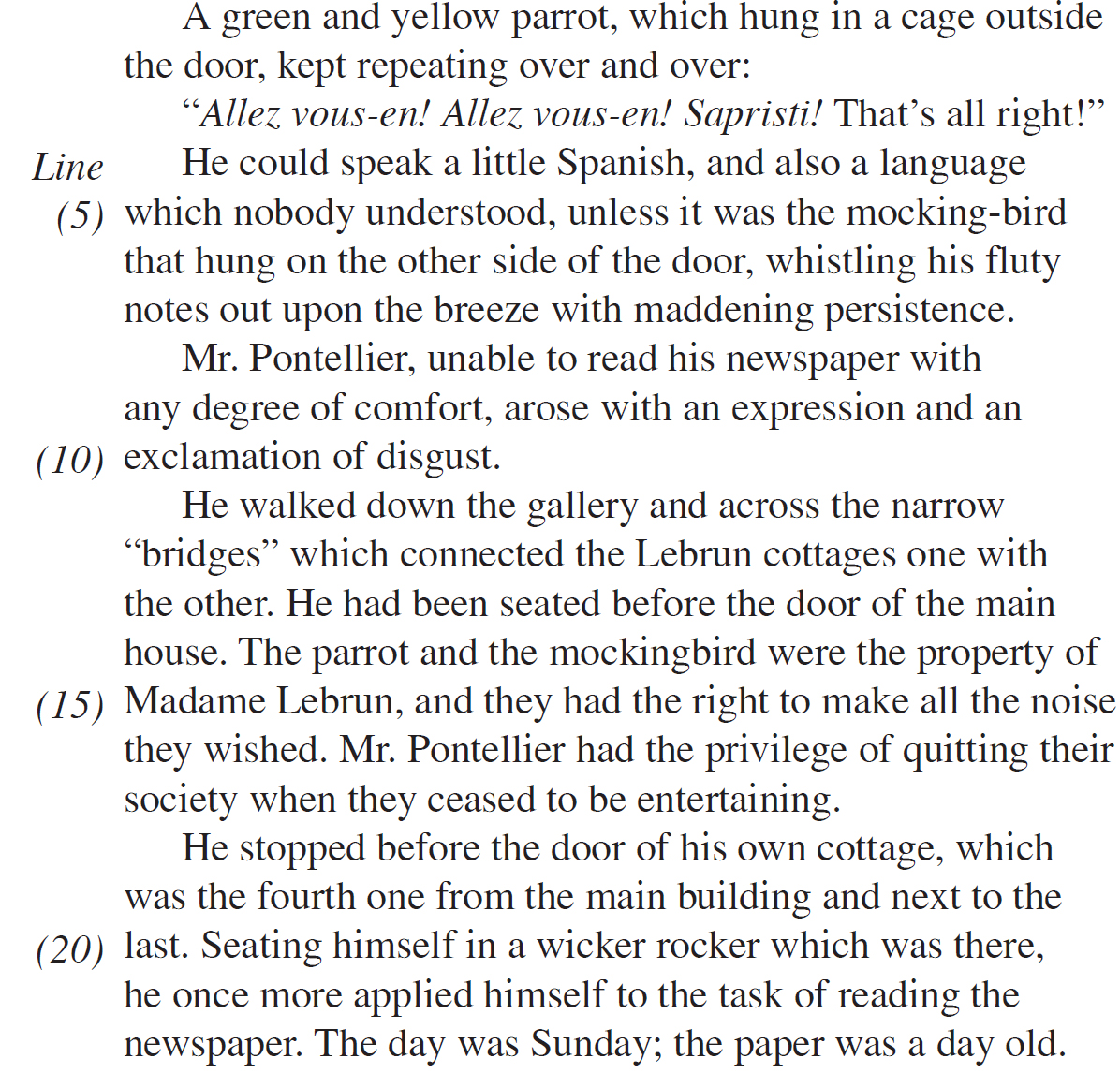
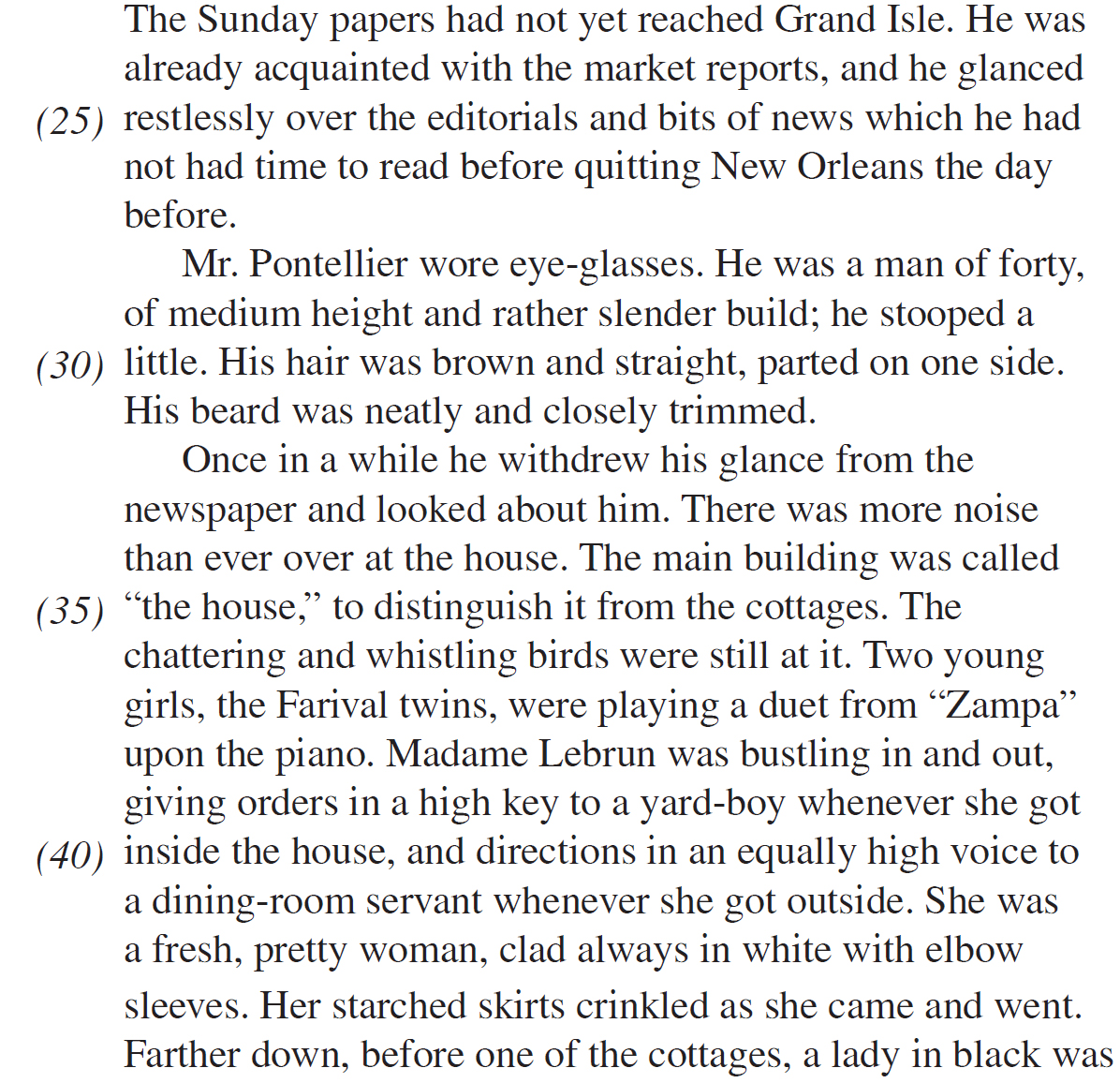
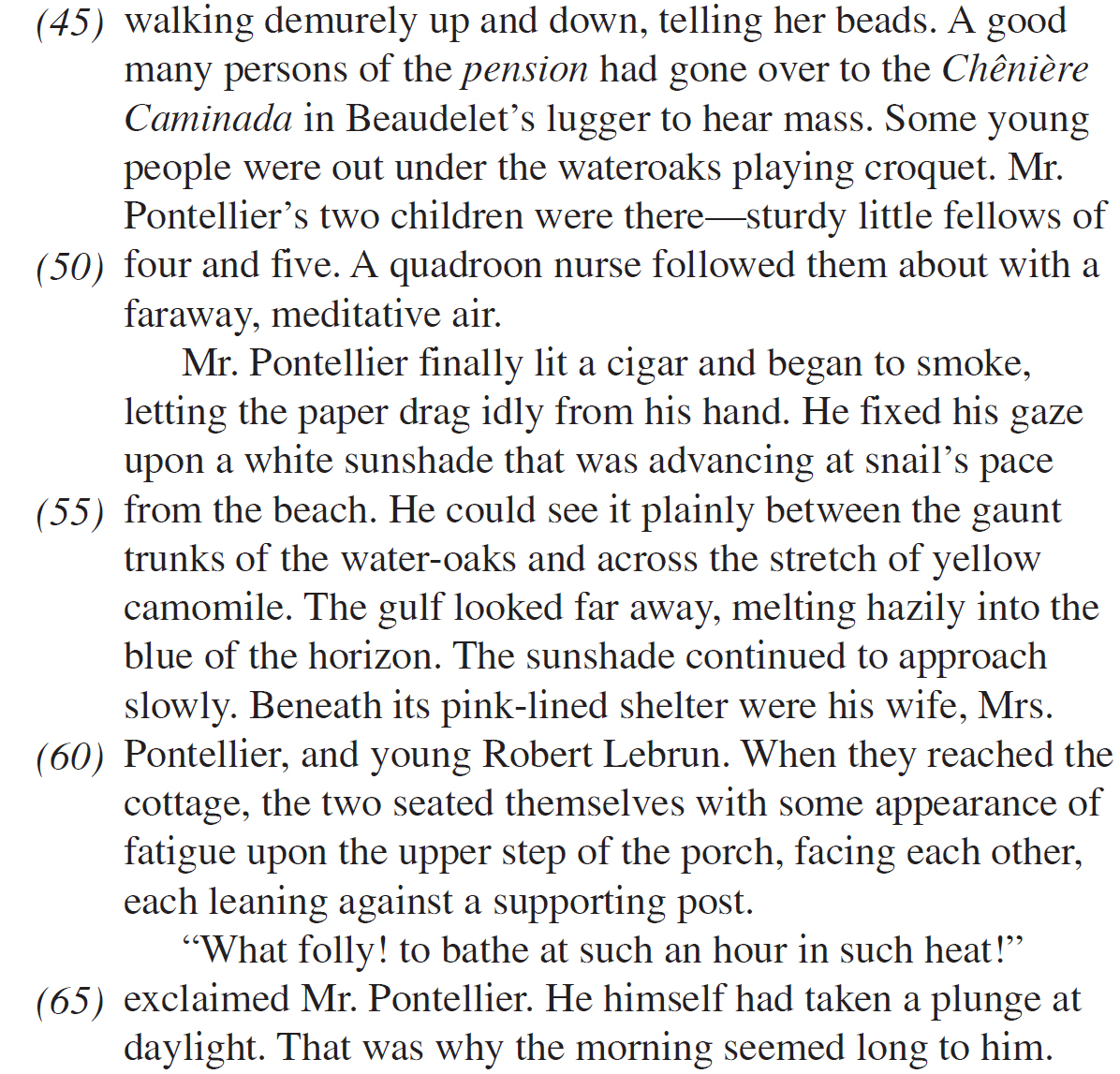
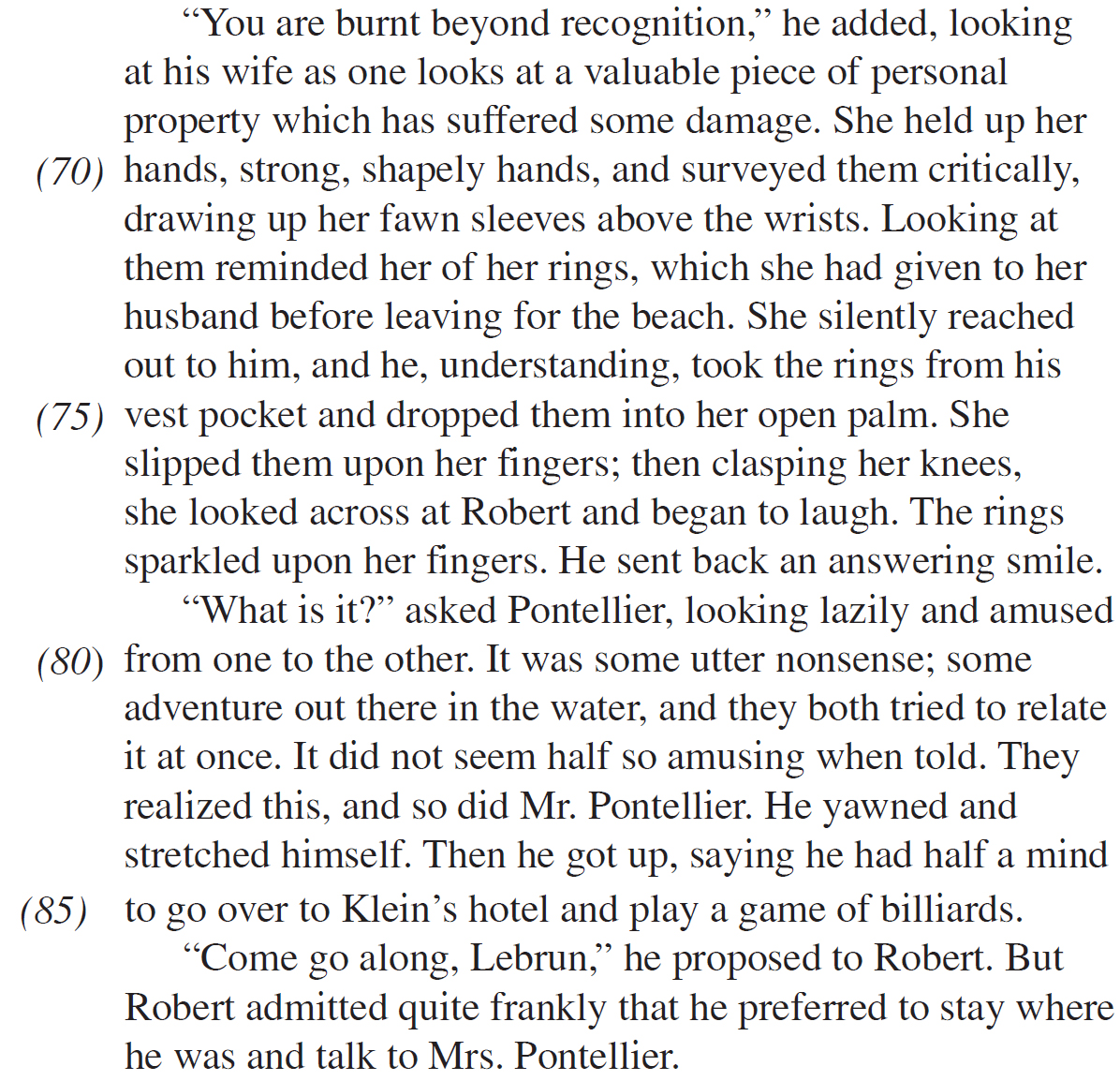

Excerpt from The Awakening by Kate Chopin (pp. 1–6). Copyright © 1899 by Herbert S. Stone & Co.
1. The tone of the beginning of the passage is
(A) cacophonous
(B) whimsical
(C) brooding
(D) satirical
(E) pastoral
2. In line 6, the word “his” is referring to
(A) the parrot
(B) Mr. Pontellier
(C) Mr. Lebrun
(D) the mocking-bird
(E) Mr. Klein
3. Lines 8–10 establish Mr. Pontellier as
(A) fastidious and officious
(B) intolerant and judgmental
(C) restless and volatile
(D) surreptitious and untrustworthy
(E) ambitious and corrupt
4. The parrot’s chatter made at the beginning of the passage helps to establish
(A) the unpleasantness of the setting
(B) Mr. Pontellier’s restlessness and discomfort
(C) the tension between Mr. Pontellier and Robert
(D) the tension between Robert and Mrs. Pontellier
(E) a sense of unease between man and nature
5. In line 26, the word “quitting” means
(A) finishing
(B) leaving
(C) giving up
(D) dismissing
(E) setting free
6. Mr. Pontellier’s attitude toward his companions on Grand Isle could be characterized as
(A) aloof
(B) curious
(C) mistrustful
(D) warm
(E) antagonistic
7. In line 49, the word “sturdy” helps to establish
(A) Mr. Pontellier’s self-satisfaction with his children
(B) the children’s ability to withstand Mr. Pontellier’s neglect
(C) parallels between the children and their mother
(D) suspicion that Mr. Pontellier is not the children’s biological father
(E) a contrast between the Pontellier children and the rest of the island’s inhabitants
8. In lines 52–66, which word complements our understanding of Mr. Pontellier’s personality?
(A) Smoke
(B) Idly
(C) Gaunt
(D) Folly
(E) Plunge
9. The use of “the sunshade” to refer to the approach of two people is an example of
(A) metonymy
(B) apostrophe
(C) hyperbole
(D) personification
(E) synecdoche
10. Lines 58–66 reveal:
I. Mr. Pontellier’s dislike of Robert
II. Mr. Pontellier’s contempt toward his wife
III. Mr. Pontellier’s self-righteousness
(A) I only
(B) II only
(C) III only
(D) I and III
(E) II and III
11. In line 67, Mr. Pontellier uses which literary device to provoke a reaction from his wife?
(A) Hyperbole
(B) Onomatopoeia
(C) Assonance
(D) Understatement
(E) Apostrophe
12. Lines 67–78 serve to introduce
(A) Mrs. Pontellier’s unattractive appearance.
(B) an indication that the relationship between Mr. and Mrs. Pontellier is strained.
(C) a suggestion that Robert is uncomfortable around Mr. Pontellier.
(D) Mrs. Pontellier’s dominant position in the marriage.
(E) Mr. Pontellier’s protectiveness toward his wife.
13. In line 87, the phrase “quite frankly” serves the purpose of
(A) establishing Robert’s stubbornness
(B) elaborating on Robert’s animosity toward Pontellier
(C) contrasting Robert’s contentment with Pontellier’s ambivalence
(D) accentuating Pontellier’s alienation from the residents of Grand Isle
(E) revealing Robert’s social status in comparison to that of Pontellier
14. The description of the interactions between Mrs. Pontellier and Robert convey a tone of
(A) unapologetic intimacy
(B) passionate longing
(C) polite tolerance
(D) underlying antagonism
(E) conspiratorial secrecy
15. Lines 86–90 serve to further clarify
I. Mr. Pontellier’s indifference toward his marriage
II. Mr. Pontellier’s disdain for his children
III. Mr. Pontellier’s fear of Robert’s influence over his wife
(A) I only
(B) II only
(C) III only
(D) I and II
(E) I and III
Questions 16–27 . Choose your answers to each of the following questions based on careful reading of the following poem by Christina Rossetti.
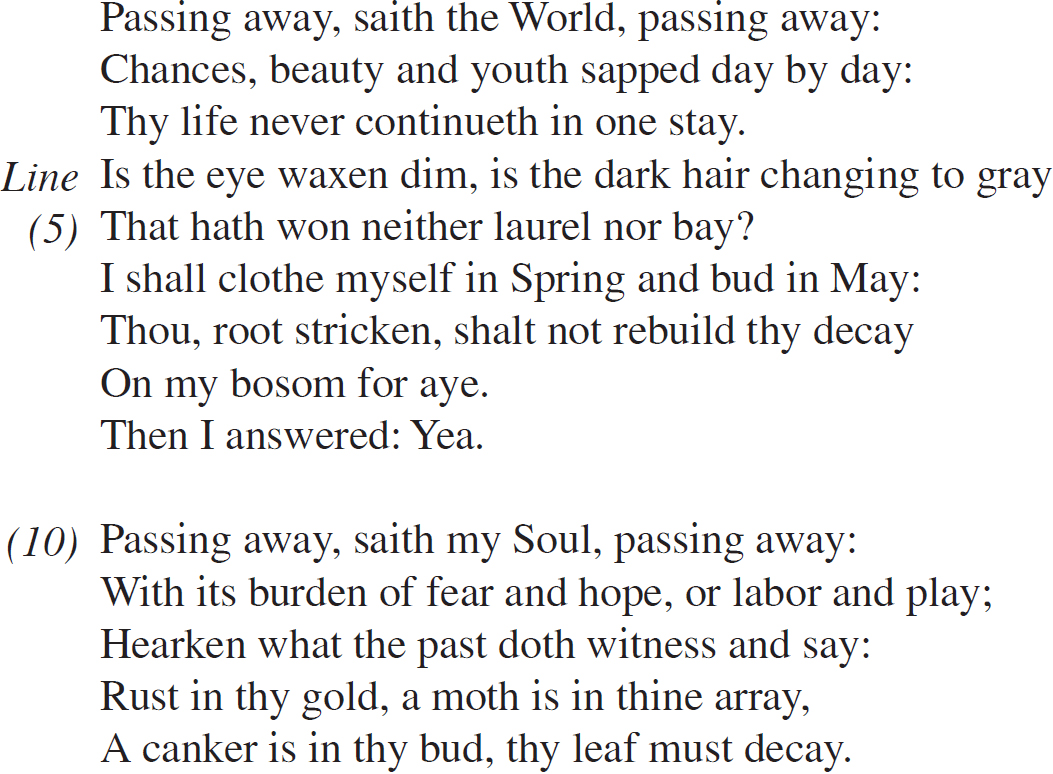
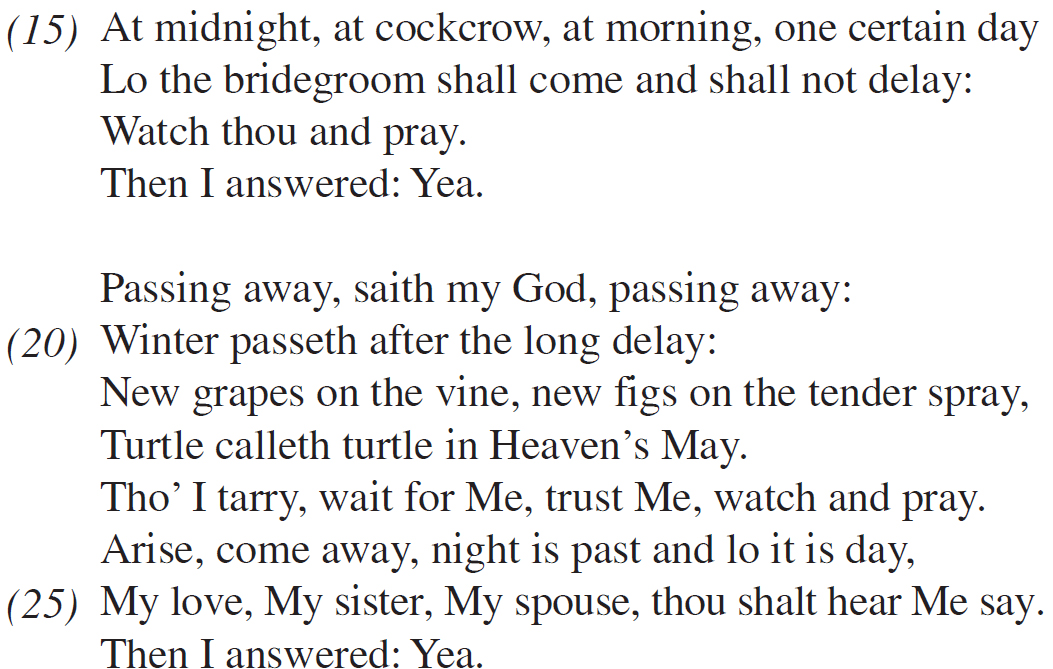
17. “Laurel” and “bay” (line 5) are allusions to
(A) flowers highly prized for their rarity which bloom briefly and beautifully and then die
(B) spices which add flavor to food and, metaphorically, to life
(C) leaves traditionally woven into wreaths to honor poets
(D) traditional symbols for Homer and Ovid, respectively
(E) traditional symbols for true faith and pious conduct, respectively
18. Lines 6–7 suggest that
(A) the principal narrator is faced with a choice between the afterlife that true faith offers or the physical corruption that awaits the unbeliever
(B) although the World has regenerative powers, the principal narrator of the poem does not
(C) paradoxically, life can sometimes emerge from death
(D) there is a natural cyclical pattern of renewal that the principal narrator has forsaken
(E) the principal narrator is gravely ill and certain to die before the spring
19. Which of the following lines contains an image NOT echoed closely elsewhere in the poem?
(A) Line 6
(B) Line 7
(C) Line 13
(D) Line 14
(E) Line 21
20. Which of the following choices best characterizes the speaker’s attitude in each of the poem’s three stanzas, respectively?
(A) Realization of death’s inevitability; fear of physical decay; passive acceptance of what cannot be escaped
(B) Nostalgia for the earthly world that must be left behind; fear of physical decay; welcome acceptance of the afterlife
(C) Realization that death will come before one’s ambitions have been achieved; dismay over the visible signs of physical decay; supplication for the healing powers of divine intervention
(D) Sorrow and mild surprise at the arrival of early death; deepening awareness of death’s certainty; hopefulness for a place in the afterlife
(E) Acknowledgment of death’s inevitability; understanding of the need to prepare oneself; happiness at the prospect of union with the divine
21. In the context of the poem “a moth is in thine array” (line 13) is intended to imply that the
(A) narrator’s attire is being eaten by moths
(B) narrator’s body is being consumed by cancer, or a cancer-like disease
(C) narrator’s soul contains a destructive element which, unless the narrator takes some action, will render it unworthy of the afterlife
(D) narrator’s soul is corrupted with sin that only death can purge
(E) narrator’s soul is getting ready for decay
22. Lines 15 and 16 suggest that
(A) the principal narrator’s final hour will come, despite the small uncertainty of knowing exactly what hour that will be
(B) the bridegroom mentioned in line 16 will arrive at three distinct times
(C) the hour when a deadly illness first infects the principal narrator cannot be avoided
(D) a mysterious and evil stranger will arrive at some time between midnight and morning
(E) the principal narrator’s soul prophesies that she will eventually meet the man who will become her beloved husband
23. In the third stanza “winter” can be taken to represent
(A) long disease
(B) earthly life
(C) the coldness of the grave
(D) mental despair
(E) aging and loss of vigor
24. Which of the following statements most accurately characterizes the relationship of the imagery in the third stanza to that of the first and second stanzas?
(A) The third stanza weaves together the wedding-day imagery of the second stanza and the springtime imagery of the first stanza, thereby reconciling those earlier stanzas’ differing views.
(B) Through its imagery, the third stanza further develops the themes which were advanced by the first stanza and then questioned by the second stanza.
(C) The third stanza echoes much of the first two stanzas’ imagery, but recasts that imagery so that what earlier had been likened to decay is instead characterized as renewal.
(D) By echoing the imagery of the earlier stanzas, the third stanza reaffirms and repeats the views advanced by those stanzas.
(E) By introducing the terms “love” and “sister,” the third stanza continues the progression by which each stanza proposes its own unique central metaphor around which to further the poem’s exploration of the themes of death and renewal.
25. Lines 7 and 8 provide an example of
(A) apostrophe
(B) doggerel
(C) enjambment
(D) mixed metaphor
(E) simile
26. In context, the word “spray” (line 21) most nearly means
(A) tree
(B) blanket
(C) a small branch
(D) a liquid mist
(E) a holy spirit
27. The grammatical subject of the sentence that begins at line 24 is
(A) “Arise”
(B) “night is past and lo it is day”
(C) “My love, My sister, My spouse”
(D) “thou”
(E) “Me”
Questions 28–40. Read the following passage carefully before you choose your answers. The selection is an excerpt from the novel Barchester Towers by Anthony Trollope.
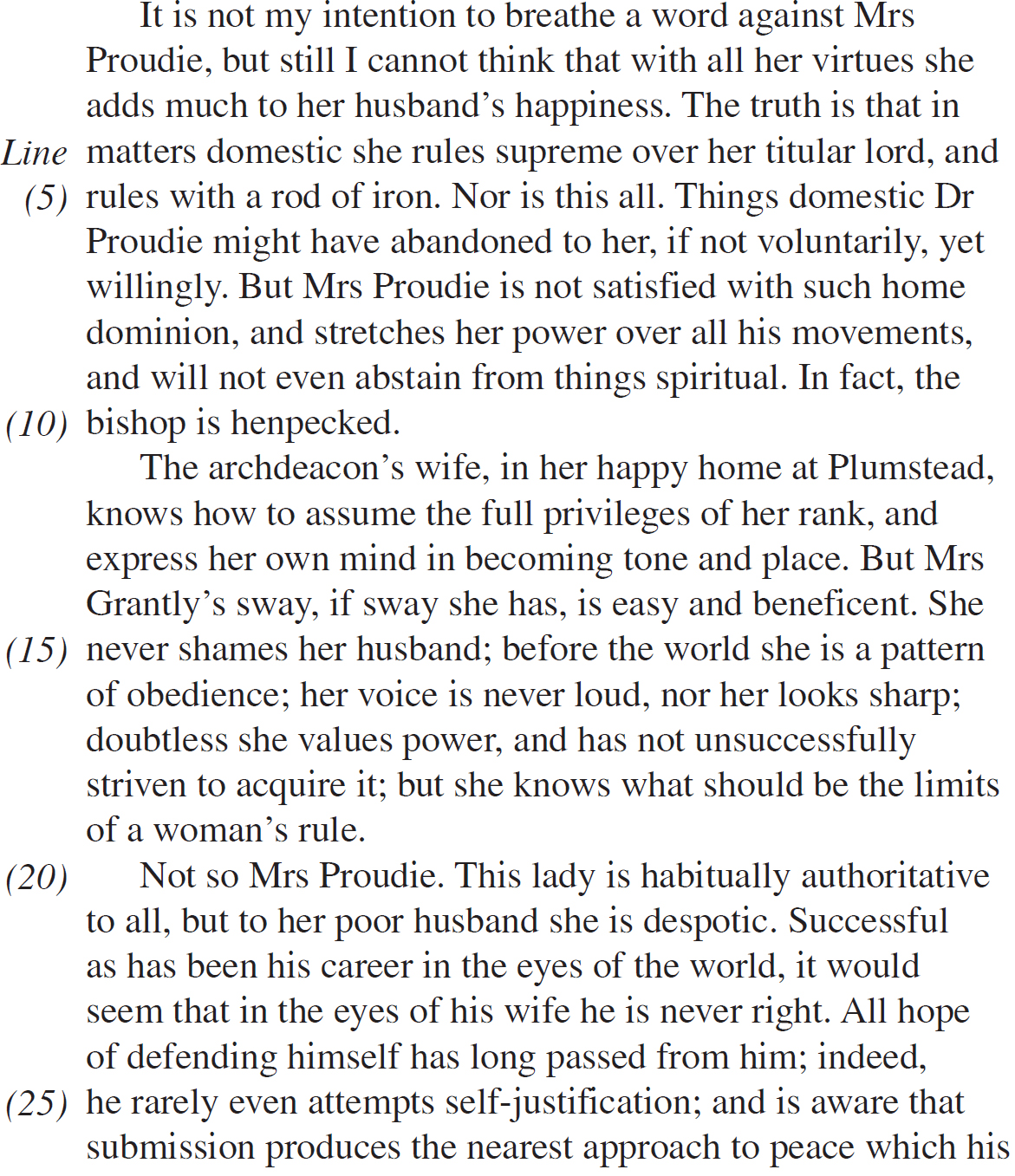
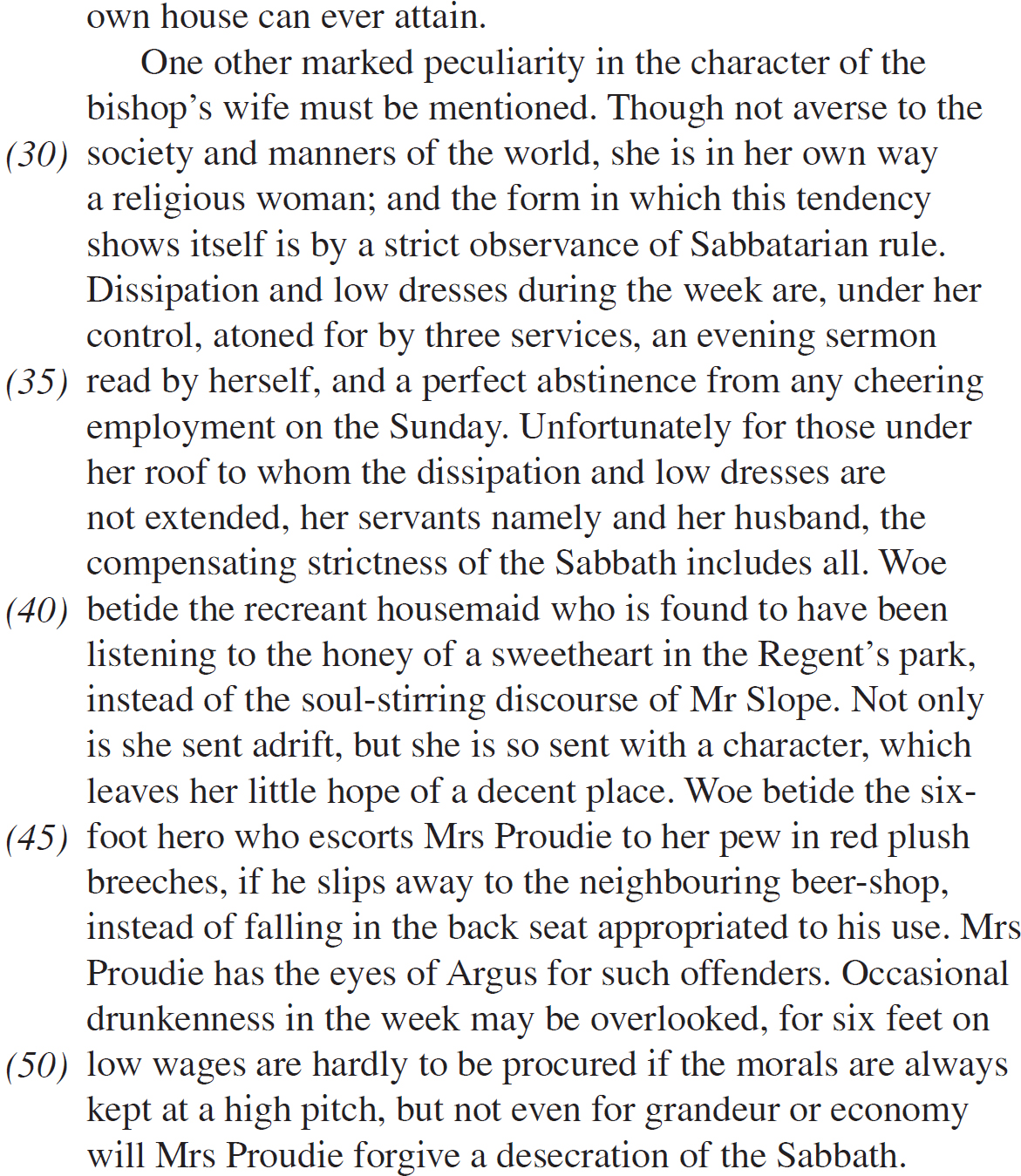
28. Which of the following descriptions is an example of the narrator’s use of irony?
(A) “It is not my intention to breathe a word against Mrs Proudie” (lines 1–2)
(B) “the bishop is henpecked” (lines 9–10)
(C) “doubtless she values power, and has not unsuccessfully striven to acquire it” (lines 17–18)
(D) “it would seem in the eyes of his wife he is never right” (lines 22–23)
(E) “a perfect abstinence from any cheering employment on the Sunday” (lines 35–36)
29. Mrs Proudie’s authoritarian character is shown most pointedly in the phrase
(A) “not satisfied with such home dominion” (lines 7–8)
(B) “knows how to assume the full privileges of her rank” (line 12)
(C) “submission produces the nearest approach to peace” (line 26)
(D) “the soul-stirring discourse of Mr Slope” (line 42)
(E) “has the eyes of Argus for such offenders” (line 48)
30. The use of the word “titular” in line 4 is an example of
(A) hyperbole
(B) metonym
(C) onomatopoeia
(D) zeugma
(E) irony
31. In the context of the passage, the phrase “if not voluntarily, yet willingly” (lines 6–7) is used to show
Dr Proudie’s attitude toward
(A) the duties that the clergy are expected to assume
(B) entering the institution of marriage
(C) strict Sabbatarianism
(D) granting his wife some power
(E) the hiring of domestic help
32. The description of Mrs Grantly serves to
(A) provide another example of the power of the aristocracy
(B) prove that Mrs Grantly henpecks her husband
(C) imply specific faults of Mrs Proudie
(D) suggest a rivalry between her and Mrs Proudie
(E) assert why women should be seen and not heard
33. The narrator’s attitude toward Mrs Proudie can best be described as one of
(A) pity
(B) objectivity
(C) emotional judgment
(D) sardonic condemnation
(E) jaded disgust
34. Which of the following best describes Dr Proudie’s relationship to his wife?
(A) Morally devoted
(B) Completely servile
(C) Awkwardly tender
(D) Thoroughly uxorious
(E) Bitterly tyrannical
35. The author attributes Dr Proudie’s attitude and behavior most clearly to
(A) ambition
(B) pride
(C) pacifism
(D) spirituality
(E) feudalism
36. In context, the word “character” (line 43) is best interpreted as meaning
(A) dubious personage
(B) reference
(C) antagonist
(D) conscience
(E) footman
37. What is the effect of the repetition of the phrase “Woe betide…” in the final paragraph?
(A) It retards the tempo of the prose.
(B) It satirizes the fate of the servants.
(C) It highlights the drama of the situation.
(D) It changes the point of view of the narrator.
(E) It emphasizes the moral consequences of the action.
38. In context, the adjective “recreant” (line 40) is best interpreted as meaning
(A) unfaithful and disloyal
(B) engaging in a pastime
(C) refreshing
(D) craven and cowardly
(E) depraved
39. Which of the following best describes the effect of the last paragraph?
(A) It suggests a cause of Mrs Proudie’s moral transformation.
(B) It introduces Mr Slope as an observer of Mrs Proudie’s actions.
(C) It illustrates how Mrs Proudie’s religious beliefs reflect her character.
(D) It counters speculations about Mrs Proudie’s character.
(E) It shows how hard it is to hire household servants.
40. The style of the passage as a whole can best be
described as
(A) humorless and pedantic
(B) effusive and subjective
(C) descriptive and metaphorical
(D) terse and epigrammatic
(E) witty and analytical
Questions 41–55 . Read the following poem by Amy Lowell carefully, and then choose answers to the questions that follow.
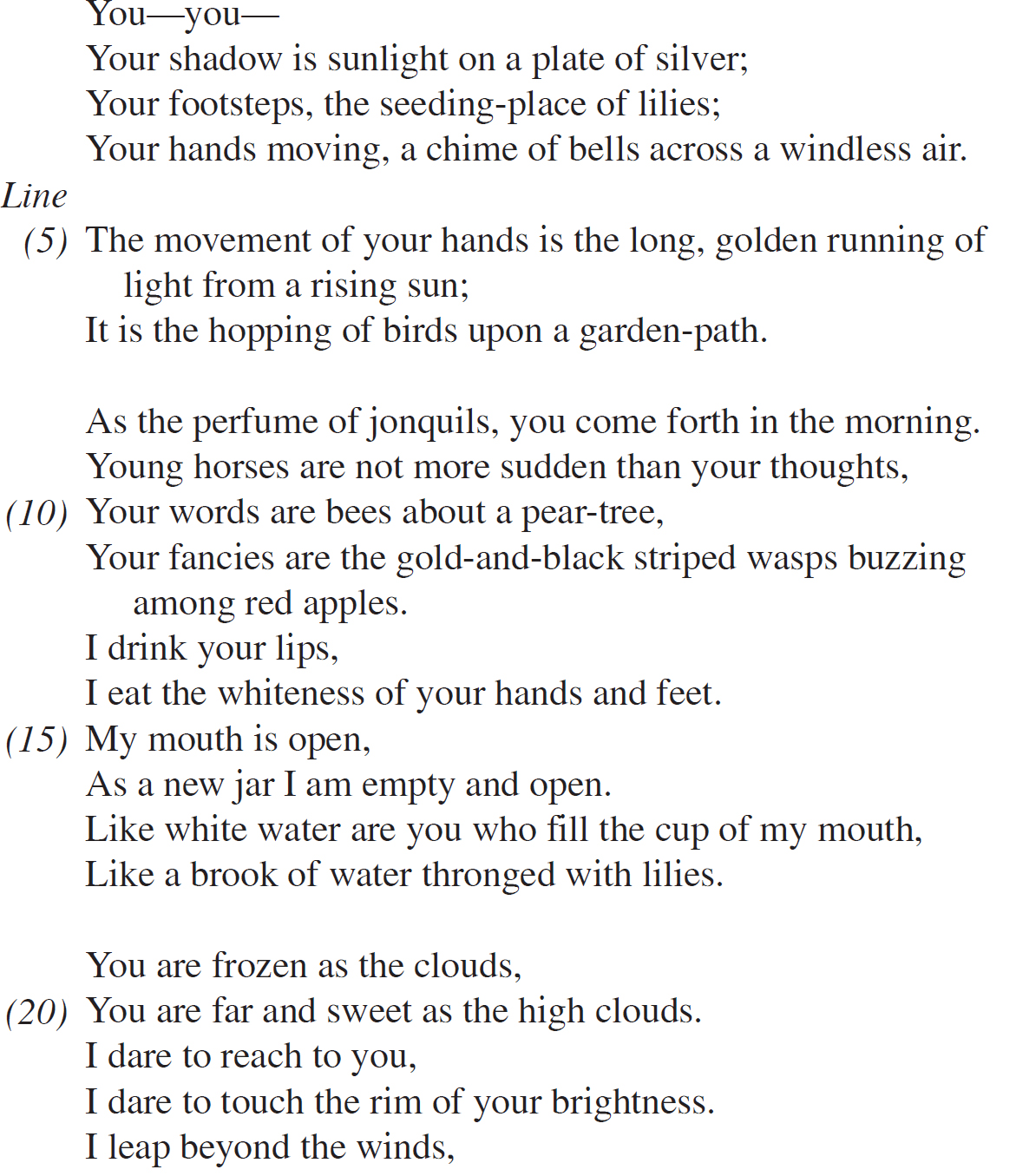
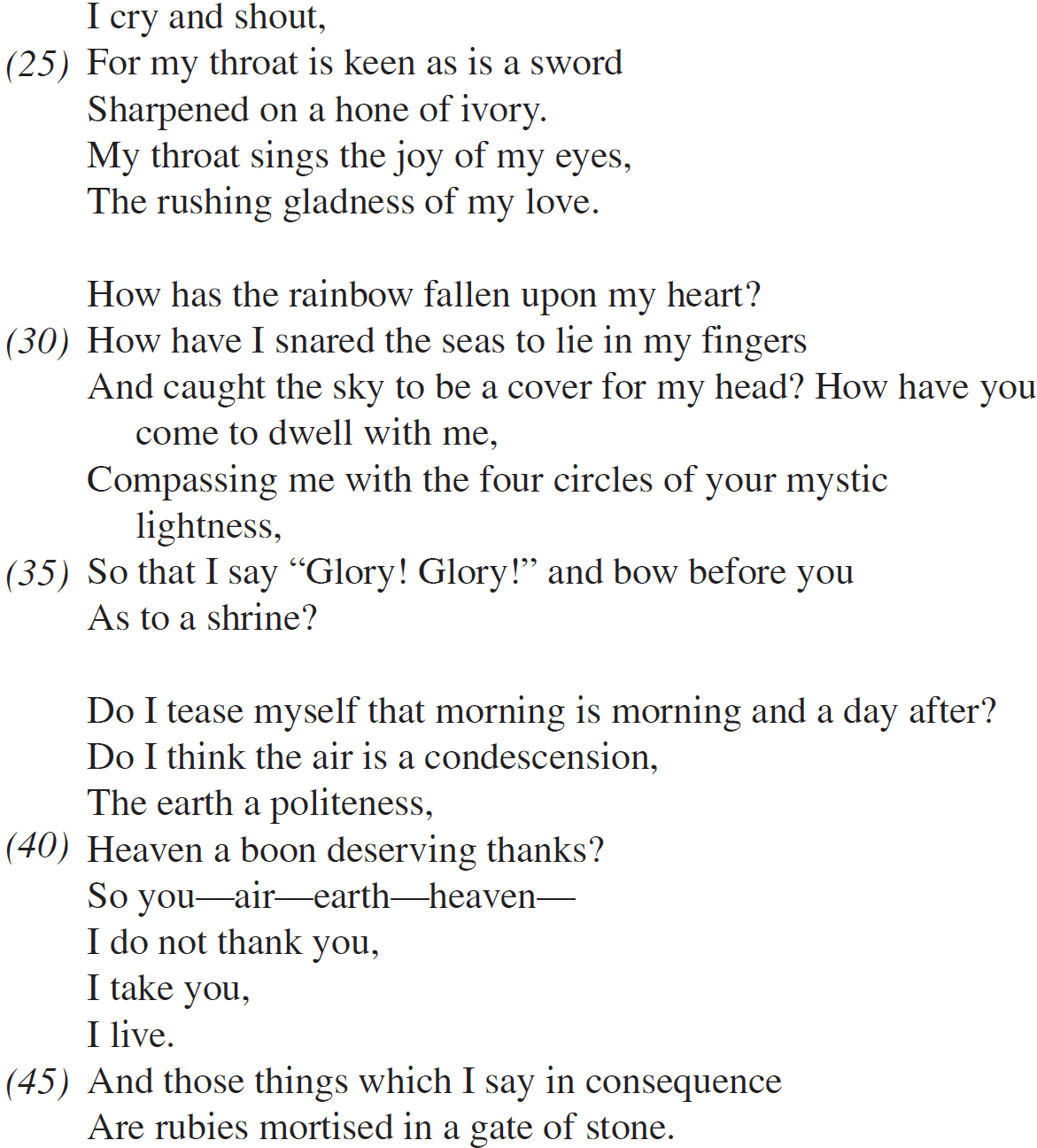
41. Overall, the speaker’s attitude toward the subject of the poem is one of
(A) reverence and need
(B) devotion and fear
(C) love and anger
(D) uncertainty and exultation
(E) piety and amazement
42. The phrase “I drink your lips,/I eat the whiteness of your hands and feet” (lines 13–14) serves to
(A) describe the antagonistic interactions of the speaker and her subject
(B) point out the beauty of the poem’s subject
(C) make clear that the speaker’s relationship to her subject is more physically based than it is emotionally significant
(D) underscore the speaker’s delight in the physical characteristics of her lover
(E) provide a figurative contrast between the speaker and her subject
43. In the last stanza, the relationship between the speaker and her subject is most directly implied to be
(A) better than breathing or eating in the opinion of the speaker
(B) as expensive and rare as gemstones
(C) a heavenly experience
(D) encompassing everything else in the world, including the air, heaven, and earth
(E) necessary to the author’s survival
44. Which of the following best conveys the meaning in context of “How have I snared the seas to lie in my fingers/And caught the sky to be a cover for my head?” (lines 30–31)?
(A) The speaker is impressed with the physical feats she can perform now that her relationship has blossomed.
(B) The speaker is impressed with how attuned her lover is to the natural world.
(C) The speaker cannot believe her good fortune at being in such a wonderful relationship.
(D) The sea and sky, representing the relationship, are protecting the speaker from harm.
(E) The speaker feels amazement at how beautiful the world around her looks because of the new perspective granted by her relationship with her lover.
45. The use of repetition and punctuation in the first line of the poem could be interpreted to suggest
(A) the speaker’s amazement at the existence of her subject
(B) the difficulty that the speaker has communicating with the poem’s subject, even though they are in love
(C) the speaker’s inability to make her sentiments clear
(D) that the speaker’s thoughts are being interrupted by everyday life or other concerns
(E) that the speaker wants to be very clear in terms of who her subject is and who she is speaking to within the context of the poem
46. The speaker compares her beloved to all of the following EXCEPT
(A) the clouds
(B) bees buzzing among fruit
(C) heaven, the earth, and the air
(D) the perfume of flowers
(E) the clear water of a brook
47. The third stanza of the poem principally suggests that
(A) the speaker of the poem is fragile, like a jar made out of pottery or glass
(B) the speaker is ready and waiting to receive the experiences and emotions that her relationship and/or her lover provides for her
(C) the speaker loves the flowers of which her lover reminds her
(D) the poem’s speaker is similar to many of nature’s treasures, such as the lilies in the brook
(E) the speaker is unable to resist her lover’s advances even when she would like to do so
48. The phrase “Compassing me with the four circles of your mystic lightness” (lines 33–34) indicates that the speaker is
(A) metaphorically surrounded by her lover
(B) lost in the beauty of the metaphorical light provided by her lover
(C) letting her lover set her direction in life
(D) unsure where to go without her lover’s presence
(E) connecting with her lover on a spiritual level
49. Which word is a metaphor for the poem itself?
(A) Sun
(B) Perfume
(C) Morning
(D) Rubies
(E) Sword
50. Which stanza most suggests the religious level of devotion felt by the poem’s speaker?
(A) 2
(B) 3
(C) 4
(D) 5
(E) 6
51. “As the perfume of jonquils, you come forth in the morning” (line 8) is an example of
(A) personification
(B) metaphor
(C) simile
(D) hyperbole
(E) metaphysical conceit
52. The poem’s final stanza suggests which of the following?
I. The speaker needs her lover in order to live.
II. The speaker’s lover is similar to the morning.
III. The speaker is thankful for the gift of heaven.
(A) I only
(B) III only
(C) I and II only
(D) I and III only
(E) I, II, and III
53. Grammatically, the word “hone” (line 26) is a
(A) verb
(B) adjective
(C) direct object
(D) noun
(E) preposition
54. The poem states or implies which of the following?
I. The speaker believes that heaven is necessary to her well-being.
II. The speaker’s lover is far away from her.
III. The speaker shows reverence for the natural world.
(A) I and III only
(B) II only
(C) I and II only
(D) I only
(E) I, II, and III
55. Which of the following best describes the use of rhetorical questions in the poem?
(A) The author uses them to imply that the speaker is questioning her religious beliefs.
(B) The author uses them as a juxtaposition with the poem’s many similes and metaphors.
(C) The author uses them to emphasize that the speaker is overwhelmed by her love.
(D) The author uses them to introduce new aspects of her characterization of the lover.
(E) The author uses them to convey the speaker’s wonder at her situation and at her lover.
STOP
END OF SECTION I
IF YOU FINISH BEFORE TIME IS CALLED, YOU MAY CHECK YOUR WORK ON THIS SECTION.
DO NOT GO ON TO SECTION II UNTIL YOU ARE TOLD TO DO SO.
ENGLISH LITERATURE AND COMPOSITION
SECTION II
Total Time—2 hours
Question 1
(Suggested time—40 minutes. This question counts as one-third of the total essay score.)
The passage that follows is excerpted from Don DeLillo’s novel Libra (1988). This selection is a fictional treatment of the young Lee Harvey Oswald, who as an adult would assassinate President John F. Kennedy. Read the passage carefully. Then write a well-organized essay concerning the methods by which the author has portrayed the subject and the substance of the portrait itself. Be sure to consider such literary elements as diction, imagery, and point of view.
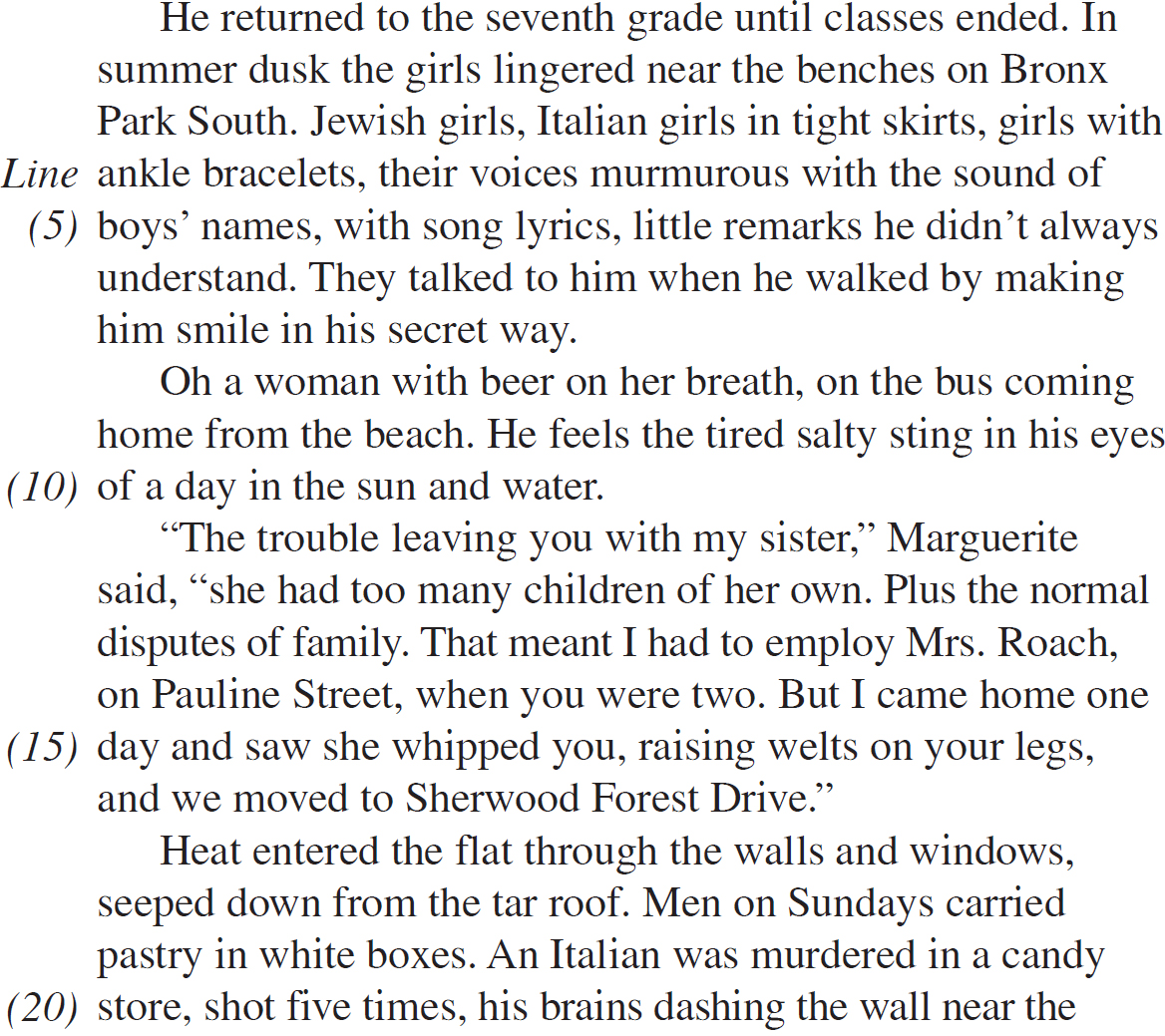
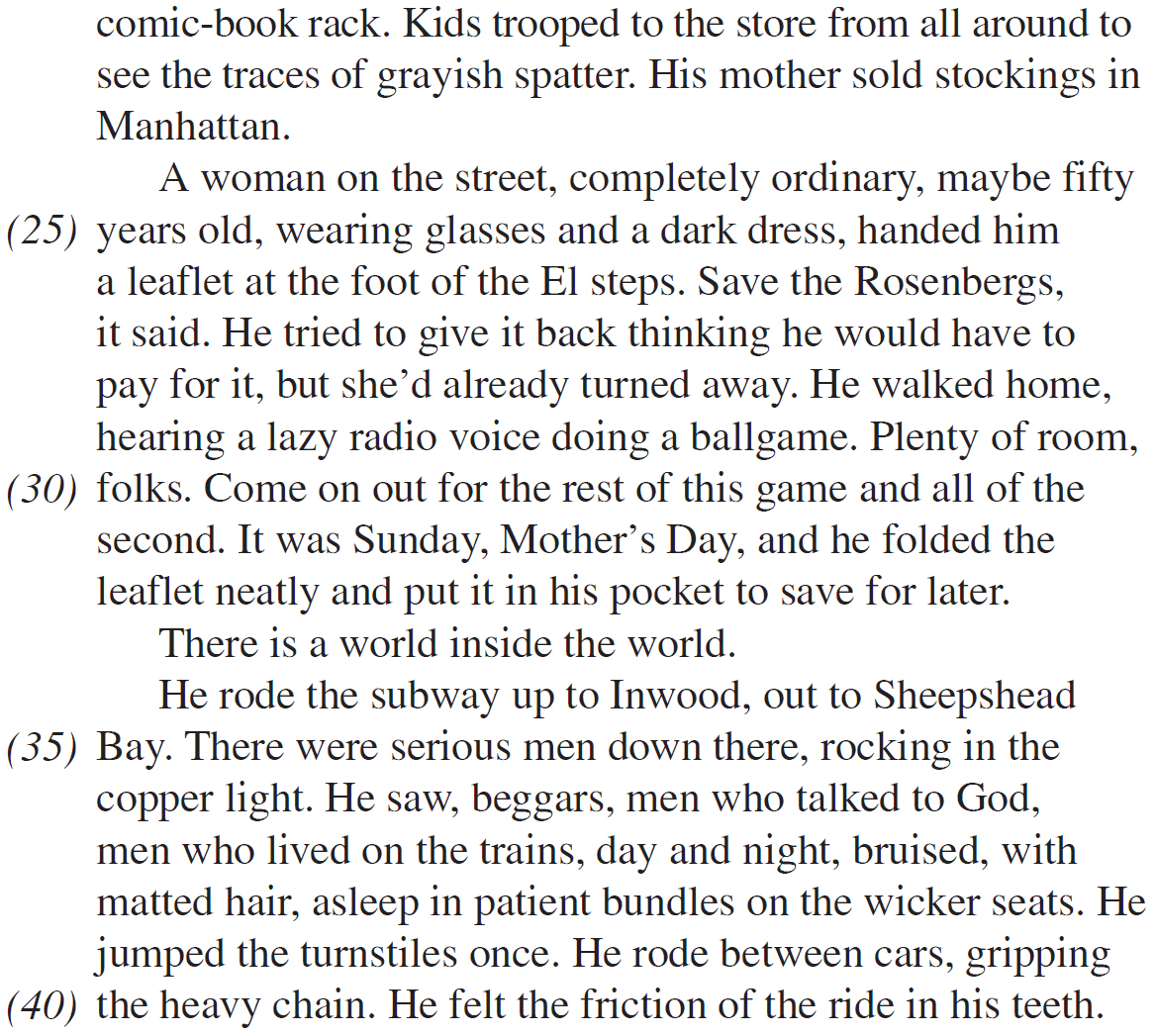
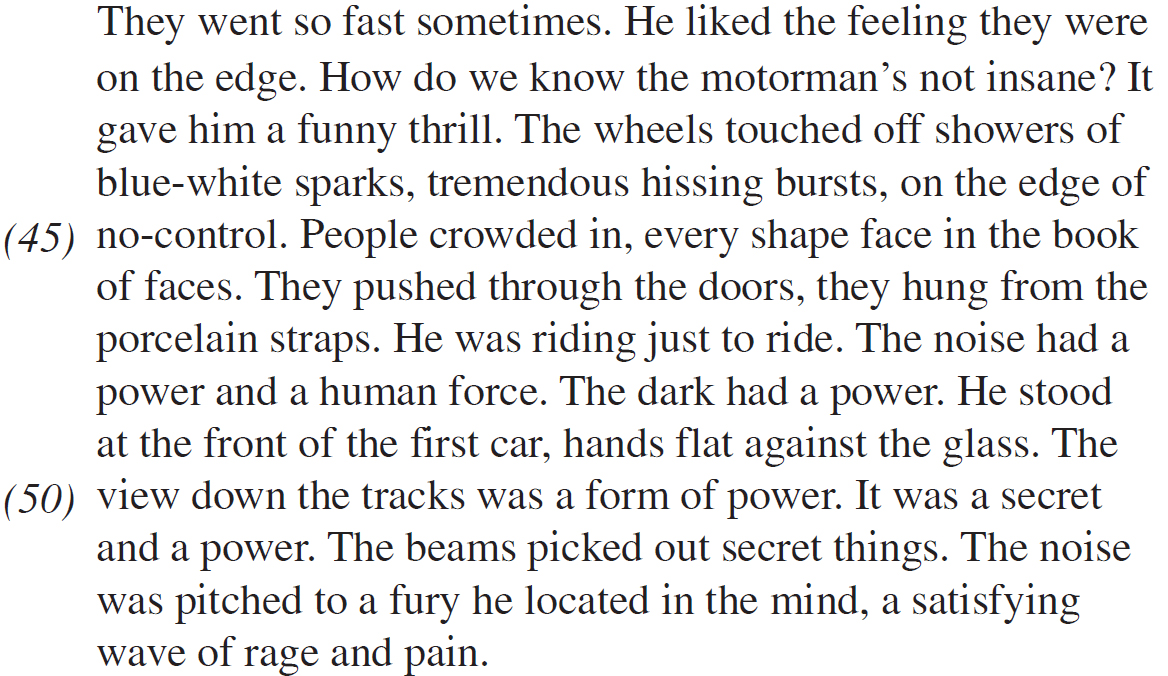
Question 2
(Suggested time—40 minutes. This question counts as one-third of the total essay score.)
Carefully read the following poems by Samuel Taylor Coleridge and William Blake. Then, in a well-organized essay, analyze how the speakers use imagery to reveal their attitudes toward infancy.
To an Infant
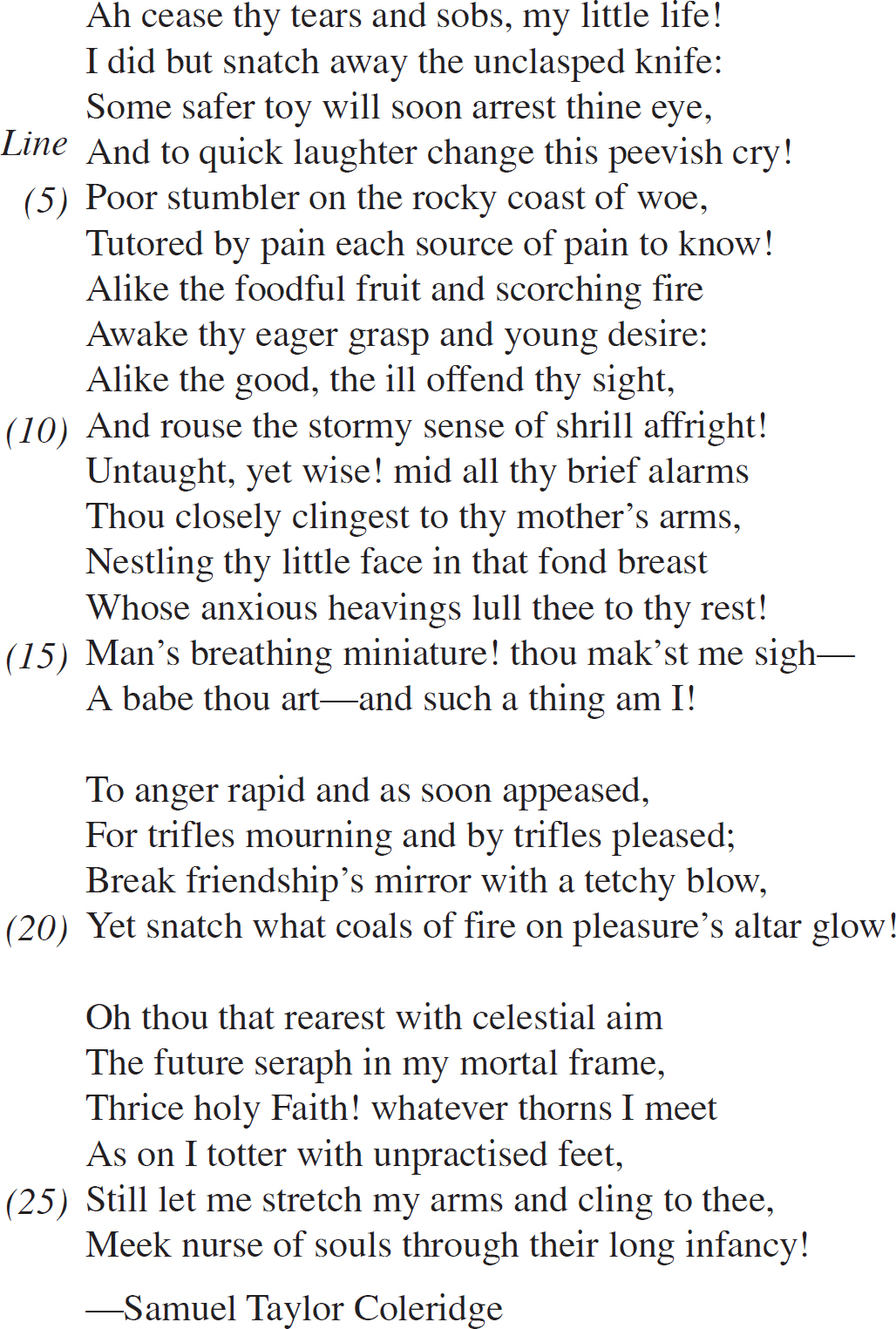
Infant Sorrow
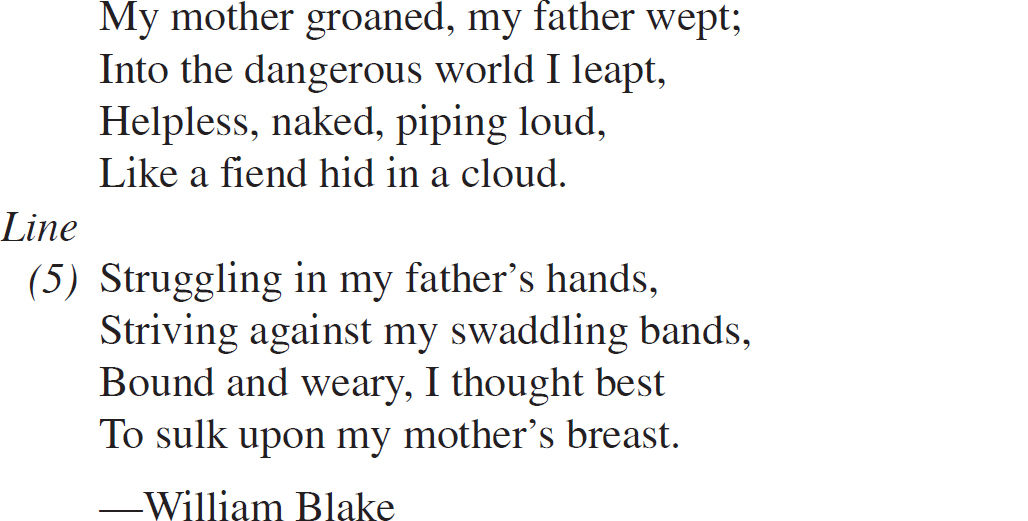
Question 3
(Suggested time—40 minutes. This question counts as one-third of the total essay score.)
“When a true genius appears in the world, you may know him by this sign, that the dunces are all in confederacy against him.”
—Jonathan Swift
“Thoughts on Various Subjects, Moral and Diverting”
In some works of literature, the main character often finds himself or herself in conflict with the social or moral values of his environment. Choose one novel or play of literary merit in which the character is at odds with the people around him or her, or with society at large. Write an essay in which you explain how these conflicts are essential to the overall meaning of the work.
You may select a work from the list below, or you may choose to write upon another work of comparable literary merit.
The Awakening
As I Lay Dying
Catch-22
Crime and Punishment
The Duchess of Malfi
A Fan’s Notes
Hamlet
Heart of Darkness
Hunger
I Know Why the Caged Bird Sings
The Idiot
The Iliad
Invisible Man
King Lear
Long Day’s Journey Into Night
Man’s Fate
Marat/Sade
Medea
Miss Lonelyhearts
Native Son
Nausea
One Flew Over the Cuckoo’s Nest
The Scarlet Letter
The Turn of the Screw
Under the Volcano
Waiting for Godot
Wuthering Heights
STOP
END OF EXAM
IF YOU FINISH BEFORE TIME IS CALLED, YOU MAY CHECK YOUR WORK ON THIS SECTION.